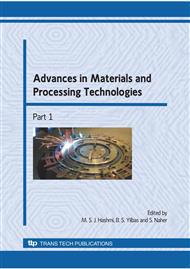[1]
P. Ulysse, R. E. Johnsen, A study of the effect of the process variables in unsymmetrical singlehole and multi-hole extrusion processes, Journal of Materials Processing Technology (JMPT) Vol. 73 (1998), pp.213-225.
DOI: 10.1016/s0924-0136(97)00231-8
Google Scholar
[2]
G. Fang, J. Zhou, J. Duszcyk, FEM simulation of aluminium extrusion through two-hole multistep pocket dies, JMPT (2007), doi: 10. 1016/j. jmatprotec. 2008. 04. 036.
Google Scholar
[3]
Z. Peng, T. Sheppard, Effect of die pockets on multi-hole die extrusion, Material Science and Engineering Vol. A407 (2005), 89-97.
DOI: 10.1016/j.msea.2005.06.048
Google Scholar
[4]
F. Chen, W. Chuang, S. Torng, Finite element analysis of multi-hole extrusion of aluminumalloy tubes, JMPT (2008), doi: 10. 1016/j. jmatprotec. 2007. 11. 292.
Google Scholar
[5]
P. Hora et all: Extrusion Zürich 2005, Proceedings of the Extrusion Benchmark 10. -11. (2005), Institute of Virtual Manufacturing, ETH Zürich.
Google Scholar
[6]
M. Schikorra, L. Donati, L. Tomesani, E. A. Tekkaya, Extrusion Benchmark 2007 - Benchmark Experiments: Study on Material Flow Extrusion of a Flat Die, Proceedings of Int. Workshop and Extrusion Benchmark (2007).
DOI: 10.4028/www.scientific.net/kem.367.1
Google Scholar
[7]
J.S. Chung and S.M. Hwang: Application of a genetic algorithm to the optimal design of the die shape in extrusion, JMPT Vol. 72 (1997), pp.96-77.
Google Scholar
[8]
A. S. Wifi, M. N. Shatla and A. Abdel-Hamid: An optimum-curved die profile for the hot forward rod extrusion process, JMPT Vol. 73 (1998), pp.97-107.
DOI: 10.1016/s0924-0136(97)00218-5
Google Scholar
[9]
P. Ulysse: Extrusion die design for flow balance using FE and optimization methods, Journal of Mechanical Sciences Vol. 44 (2002), pp.319-341.
DOI: 10.1016/s0020-7403(01)00093-5
Google Scholar
[10]
S. K. Lee, D.C. Ko and B.M. Kim: Optimal die profile design for uniform microstructure in hot extruded product, Journal of Machine Tools & Manufacture Vol. 40 (2000), pp.1457-1478.
DOI: 10.1016/s0890-6955(00)00008-0
Google Scholar
[11]
H. H. Jo, S.K. Lee, D. C. Ko and B. M. Kim: A study on the optimal tool shape design in a hot forming process, JMPT Vol. 111 (2001), 127-131.
DOI: 10.1016/s0924-0136(01)00537-4
Google Scholar
[12]
N. H. Kim, C. G. Kang and B. M. Kim: Die design optimization for axisymmetric hot extrusion of metal matrix composites, J. of Mechanical Sciences Vol. 43 (2001), pp.1507-1520.
DOI: 10.1016/s0020-7403(00)00068-0
Google Scholar
[13]
M. P. Reddy: Analysis and Design Optimization of Aluminum Extrusion Dies, Proceedings of the 8th Aluminum Extrusion Technology Seminar (2004), Orlando, USA.
Google Scholar
[14]
D. Y. Yang: Computer-Aided Optimization of Metal Forming Processes as Applied to 3-D Extrusion of Profiles, 8th Conference of Technology of Plasticity (2005), Verona, Italy.
Google Scholar
[15]
W. Xianghong, Z. Guoqm, L. Yiguo and M. Xinwu: Numerical simulation and die structure optimization of an aluminum rectangular hollow pipe extrusion process, Materials Science and Engineering Vol. 435-436, 266-274.
DOI: 10.1016/j.msea.2006.06.114
Google Scholar
[16]
M. Schikorra, M. Schomäcker, T. Kloppenborg, A. E. Tekkaya, Simulation and Experimental Investigations on Composite Extruded Processes, Ninth International Aluminum Extrusion Technology Seminar 2008, Orlando, USA, 297-307.
Google Scholar
[17]
T. Kloppenborg, M. Schikorra, M. Schomäcker, A. E. Tekkaya: Numerical Optimization of Bearing Length in Composite Extrusion Processes, Proceedings of International Workshop and Extrusion Benchmark (2007), Bologna, Italy, ISBN 978-88-548-1286-4.
DOI: 10.4028/www.scientific.net/kem.367.47
Google Scholar
[18]
U. Schramm: Structural Optimisation - An Efficient Tool in Automotive Design, Automobiltechnische Zeitschrift Vol. 06 (1998), offprint.
Google Scholar


